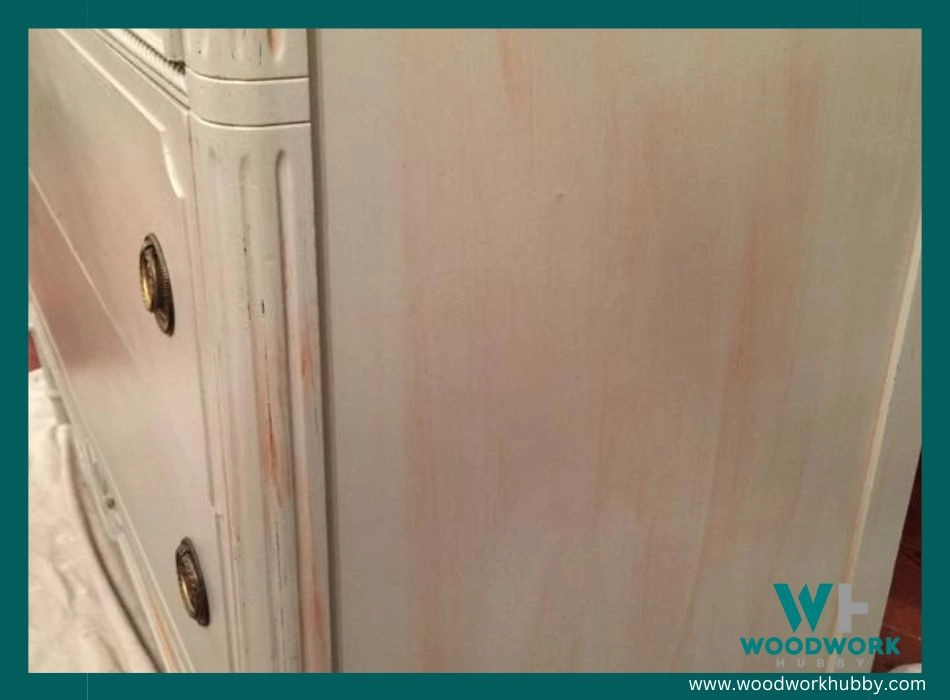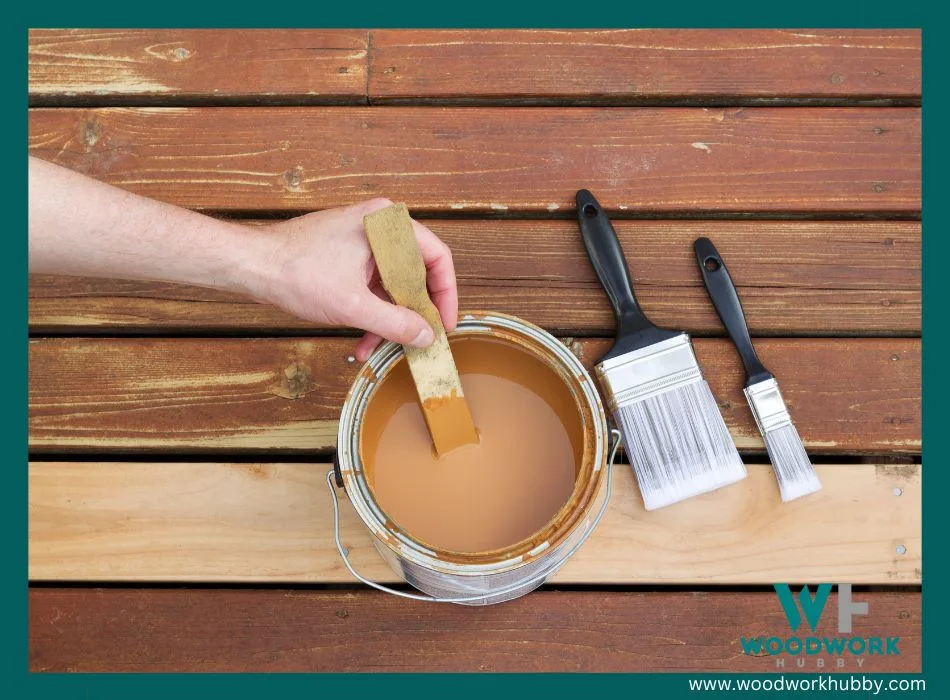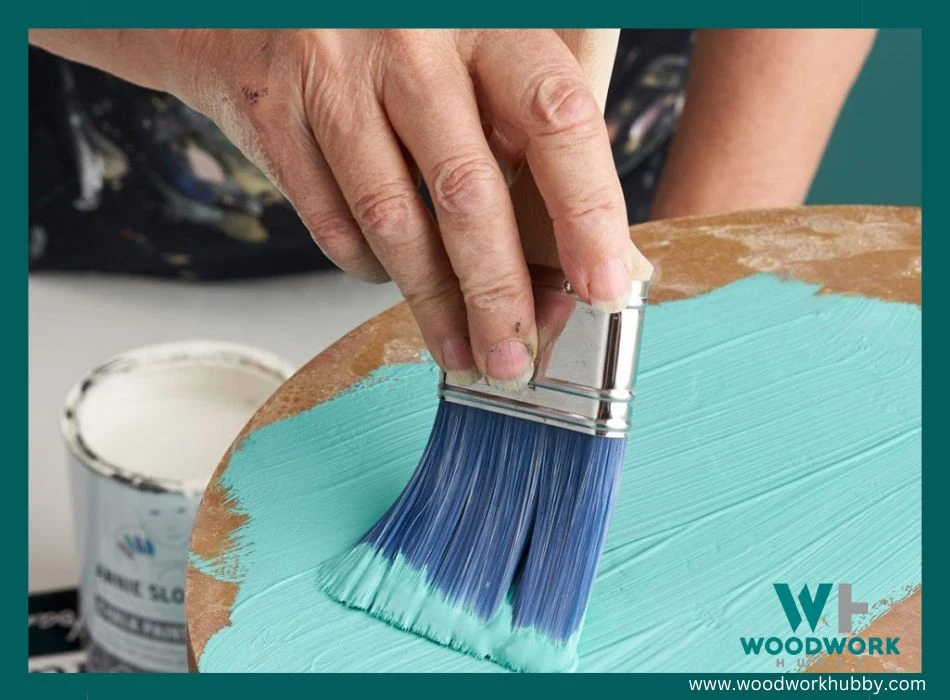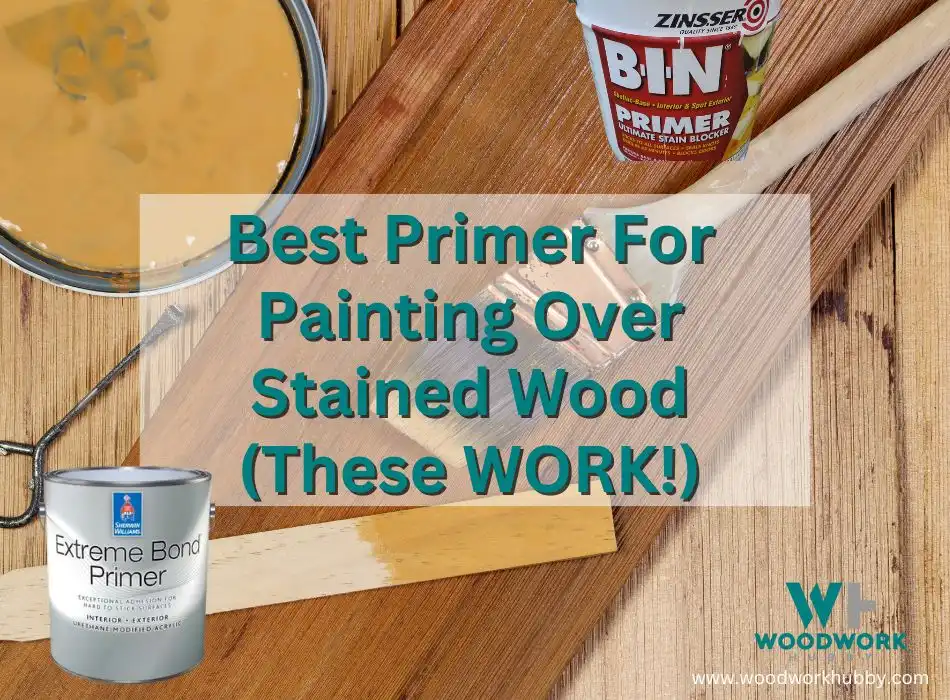Are you struggling to paint over stained wood and having issues with optimal coverage? Believe me, I’ve been there too. After trying out various products and methods, I found the best primer for painting over stained wood!
This blog post will walk you through selecting the best primer for painting over stained wood, taking into account your specific needs and desired results.
Key Takeaways
- Choosing the right primer is crucial for painting over stained wood to ensure optimal coverage and prevent bleed-through issues.
- My top pick is Zinsser Rust-oleum
- Shellac-based primers are highly recommended for sealing wood and blocking stubborn stains, such as tannin bleed-through.
- Proper surface preparation, including cleaning and sanding the wood, is essential for achieving a professional-looking finish when painting over stained wood.
- Testing the compatibility of chalk paint with the chosen primer is important to ensure adhesion before proceeding with painting.
Understanding the Challenges of Painting Over Stained Wood
Painting over stained wood can present several challenges, including potential bleed-through issues, the importance of proper stain sealing, and the need for thorough surface preparation.
Bleed-through issues
Bleed-through issues can ruin your painting job. This occurs when a brown or yellow stain peeps through the paint. The main cause is often the wood’s natural tannins, known as tannin bleed-through.
It makes your woodwork look bad and it is not easy to fix once you notice it. Using a primer helps stop this problem. A good primer acts like a solvent and takes out the stain from the wood before you even start painting.

Some primers such as shellac-based ones are very good at blocking stains on stained wood and they stop bleed-through well.
Zinsser Rust-oleum
My Recommendation As The Best Primer
- Exterior/Interior use previously painted drywall, cured plaster, wood, metal, concrete and more
- High-hiding oil-based primer hides dark colors, penetrates and seals exterior wood and blocks tannin bleed
- Excellent stain blocker permanently blocks and seals tough stains from fire, smoke and water damage
Importance of stain sealing
Stain sealing is very important before you paint over stained wood. Without it, the stain can spoil your paint job. The primer keeps the stains from showing up on your new paint. This is called bleed-through.
A good primer also stops water marks from tanning or wood pigments. If water gets into the wood, these parts can turn a dark color and show through the new paint too. This problem is known as tannin extraction which often happens when painting furniture.

Proper surface preparation
To get ready for painting, we have to prepare the wood’s surface. This is key. First, we need to test for any damp spots on the wood. We can’t paint if it’s too wet! Next comes a good clean-up.
Dirt and dust won’t let the paint stick well. Bare wood has many small holes and rough parts. A primer helps us cover those up for a smooth look in the end. It also stops things like tannin bleed-through from showing up later on our fresh paint job!
Choosing the Right Primer for Painting Over Stained Wood
When painting over stained wood, it’s crucial to use the right primer to ensure a smooth and long-lasting finish. Primers not only help with adhesion but also block any bleed-through from the stain.
There are various types of primers available for this specific purpose, including shellac-based primers and specialty stain-blocking primers like Sherwin Williams Extreme Bond P. Before selecting a primer, it’s essential to test its compatibility with the type of paint you plan on using, especially if you’re opting for chalk paint.
Video on how to choose the best primer
Benefits of using a primer
Using a primer when painting over stained wood has many benefits. A primer helps to cover up existing stains on the wood, ensuring that they don’t bleed through the new paint. It also provides a proper surface for the paint to adhere to, improving its longevity and durability.
Primers have sealing properties that prevent moisture from seeping into the wood, protecting it against damage. Additionally, using a primer can help achieve a smooth and even finish, ensuring professional-looking results.
By choosing the right primer for painting over stained wood, such as a stain-blocking or adhesion-promoting primer, you can ensure that your paint job lasts longer and looks great.
Types of primers for stained wood
When painting over stained wood, it’s important to choose the right primer. Here are some types of primers that work well for stained wood:

- Wood primer: This type of primer is specifically designed for wood surfaces and helps create a smooth base for paint.
- Stain-blocking primer: These primers are specially formulated to block stains from bleeding through the paint. They are effective at covering up dark or stubborn stains on wood.
- Interior primer: If you’re painting inside your home, using an interior primer is recommended. These primers are designed to withstand indoor conditions and provide good coverage on stained wood.
- Exterior primer: For outdoor projects, it’s important to use an exterior primer that can withstand weather conditions and protect the wood from moisture damage.
- Sealing primer: A sealing primer is useful when dealing with highly porous or damaged wood surfaces. It helps seal the wood and create a smooth surface for painting.
- Oil-based primer: Oil-based primers are known for their excellent adhesion properties and ability to block stains effectively. They are a popular choice when painting over stained wood.
- Shellac-based primer: Shellac-based primers, such as Zinsser Rust-oleum, are great for sealing wood and blocking stains. They have good coverage for stains and can reduce the number of coats needed for painting over stained wood.
Testing for compatibility with chalk paint
I wanted to make sure that the chalk paint I was using would adhere properly to the stained wood, so I decided to do a compatibility test. Chalk paint doesn’t always have the same adhesion as some primers, so it’s important to check before painting.

I applied a small amount of chalk paint on an inconspicuous area of the stained wood and let it dry. Then, I gently ran my finger over it to see if any paint came off.
If the paint stayed in place without peeling or rubbing off easily, then I knew it was compatible with the chalk paint and I could proceed with painting my project.
Steps for Properly Prepares Stained Wood for Painting
To ensure a successful paint job, it’s essential to properly prepare stained wood surfaces. This involves removing hardware and drawers, thoroughly cleaning the surface, sanding to create a suitable base, and making any necessary repairs.
Read on to learn more about these crucial steps for painting over stained wood.
Removing hardware and drawers
Before painting stained wood, it is important to remove any hardware such as door knobs or furniture pulls. This will make the cleaning process easier and ensure better results. By taking the time to remove these items, you can access every part of the surface and avoid getting paint on them accidentally.
Additionally, removing drawers allows you to reach hidden areas that may have collected dust or grime over time. Remember to keep all removed hardware in a safe place so they can be easily reattached once the painting is complete.
Video that shows how to paint over stained wood
Taking this step will give you a clean canvas for your painting project and help achieve a professional-looking finish.
Thoroughly cleaning the surface
Before painting over stained wood, it is essential to thoroughly clean the surface. This step helps remove dust, dirt, and cobwebs that can affect the paint’s adhesion. To start, I use a cleaning solution with warm soapy water to wipe down the stained wood surface.
This helps loosen any grime or residue that may have accumulated over time. Once cleaned, I make sure to remove all traces of dust by using a tack cloth or damp microfiber cloth. Wiping off any remaining dust particles ensures a smooth and flawless paint application later on.
Finally, it’s important to let the surface dry completely before moving on to the next step, as painting on a wet or damp surface can lead to poor results. Taking the time for proper cleaning sets the foundation for achieving a professional-looking paint job on stained wood surfaces.
Sanding to create a suitable base
Preparing stained wood for painting requires sanding to create a suitable base. Sanding helps smooth the surface and remove any rough areas, ensuring better adhesion of the paint. It is an essential step in achieving a professional-looking finish.
Start by using medium grit sandpaper to even out the surface, then follow with finer grit sandpaper for a smoother result. By properly sanding the stained wood, you’ll provide a solid foundation for your paint job and help it last longer.
Remember, even if claims are made that no sanding is necessary, some amount of sanding is still recommended for optimal results.
Optional repairs
If your stained wood has any nicks, scratches, or dings that you want to fix before painting, you can use wood filler. Simply apply the filler to the damaged areas and smooth it out.
Depending on the depth of the damage, you may need to apply two coats for a proper repair. After applying the wood filler, make sure to sand and clean the surface thoroughly before proceeding with painting.
This will ensure that you have a smooth and even base for your primer and paint.
Best Primers for Painting Over Stained Wood
In this section, we will test and evaluate the top performers to find the best primers for painting over stained wood. One of the top contenders is Sherwin Williams Extreme Bond P primer, which provides excellent adhesion and stain-blocking properties.
Another option worth considering is shellac-based primers, known for their superior sealing abilities on stained wood surfaces. Stay tuned as we delve deeper into these options and uncover more recommendations for achieving a flawless finish when painting over stained wood.
Testing and evaluation of top performers
I tested and evaluated different primers for painting over stained wood to find the best ones. Seal Grip from PPG and Stix were the top performers in my tests. They were effective at sealing stains on wood and had great hiding ability, making them ideal for covering up dark stains.
These primers are excellent choices when you want to ensure that your painted surface looks smooth and flawless. Whether you’re dealing with light tannin staining or severe stains, these top-performing primers will give you the results you need for a successful paint job.
Shellac-based primers
I highly recommend using shellac-based primers when painting over stained wood. These primers are fantastic at bonding to any surface, including wood and antique furniture. They have excellent stain-blocking properties, which means they can seal the wood and block out stubborn stains.
This is especially important for preventing tannin bleed-through, where tannins in the wood come through the paint. Shellac-based primers also provide great adhesion, making them perfect for tricky surfaces like glass.
They are commonly used in furniture painting projects to achieve a smooth and long-lasting finish.
Tips and Techniques for Painting over Stained Wood
When painting over stained wood, using a latex primer and paint is ideal for water-based stains, while oil-based stains require special considerations. Additionally, achieving a matte finish can be done with chalk paint and a polyurethane top coat.
Using latex primer and paint for water-based stains
When painting over water-based stains on wood, it is recommended to use latex primer and paint. Latex products adhere well to water-based stains, providing good coverage and a smooth finish.
By using a latex primer first, you can ensure that the paint will properly adhere to the stained surface. This helps prevent peeling or chipping of the paint later on. Additionally, latex paint is easy to clean up with soap and water, making it convenient for DIY projects.
So if you’re dealing with water-based stains on your wood surfaces, remember to use latex primer and paint for best results!
Special considerations for oil-based stains
When painting over oil-based stains, there are some special things to keep in mind. First, use an oil-based primer for the best results. This type of primer will provide good adhesion and help prevent any bleeding through the paint.
Also, make sure to lightly sand the surface before painting to create a rough texture that allows the paint to stick better. Finally, be aware that oil-based primers can have a strong odor, so proper ventilation is important when working with them.
By following these considerations, you can achieve a smooth and long-lasting finish when painting over oil-based stained wood.
Achieving a matte finish with chalk paint and polyurethane top coat
When using chalk paint over stained wood, it is possible to achieve a matte finish by applying a polyurethane top coat. Chalk paint manufacturers claim that sanding or priming is not necessary when using their product on stained wood.
To create the desired matte effect, simply apply the chalk paint directly onto the stained wood surface. Once the paint has dried, apply a thin and even coat of polyurethane top coat.
This will not only protect the painted surface but also provide a smooth and matte finish. With this technique, you can transform your stained wood into a beautifully painted piece with an elegant matte appearance.
Conclusion – Best Primer For Painting Over Stained Wood
In conclusion, choosing the right primer is crucial when painting over stained wood. Shellac-based primers like Zinsser are recommended for their ability to seal wood and prevent bleed-through.
Oil-based and acrylic primers are also good options. Make sure to properly prepare the surface by cleaning and sanding, and consider the type of finish on the wood. With the right primer and proper techniques, you can achieve great results when painting over stained wood.
FAQs
1. Can I paint over stained wood without using a primer?
While it is possible to paint over stained wood without a primer, using a primer will help improve adhesion and ensure better results.
2. What is the best primer for painting over stained wood?
An oil-based or shellac-based primer is generally recommended for painting over stained wood as they have excellent stain-blocking properties.
3. Do I need to sand the stained wood before applying a primer?
It is important to lightly sand the stained wood surface before applying a primer to ensure proper adhesion and smooth finish.
4. How many coats of primer should I apply on stained wood?
One coat of primer is usually sufficient when painting over stained wood, but if the stain bleeds through or you want extra coverage, applying two coats can be beneficial.





